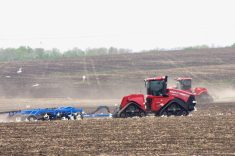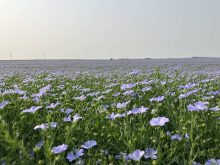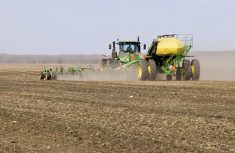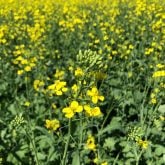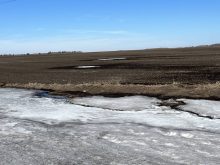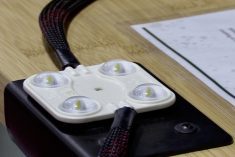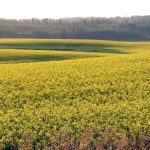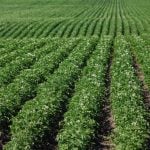Despite the wet conditions, seeding progress was made throughout much of the province last week and is now estimated to be 83 per cent complete. Canola and soybean planting advanced, with 71 per cent of canola acres planted and 82 per cent of soybean acres planted. Spring cereals are estimated to be 87 to 94 per cent complete, peas are 97 per cent complete, grain corn is 95 per cent complete. Planting order has been changed on some farms, and fields are getting planted as soil conditions permit.
Cereals
Fall rye and winter wheat fields range from stem elongation to booting, with the earliest fall rye heading. Spring wheat seeding is at 94 per cent complete, barley seeding is at 88 per cent and oats is at 87 per cent across the province.
Read Also

Squid fertilizer draws interest at Ag In Motion
GreenFlow says its Squid Juice might elicit a smile or chuckle, but insists the fertilizer and its benefits are for real.
The most advanced spring wheat has three to four leaves and two tillers.
Grain corn planting is 95 per cent complete with most of the early planted corn at V3 stage.
Oilseeds
Canola planting is at 71 per cent completion across the province, and ranges from cotyledon to two true leaves.
Sunflower planting is at 53 per cent completion across the province, with the earliest seeded sunflowers at the cotyledon to first true leaf stage.
Flax is at 64 per cent completion across the province.
Pulses and Soybeans
Field pea planting is at 97 per cent completion across the province, with the earliest fields at the three to five node stage.
Soybean planting is at 82 per cent completion across the province, with the most advanced fields at the unifoliate stage.
Dry bean planting is at 66 per cent completion across the province.
Forages and Livestock
Forages
There is strong growth in pastures and hayfields, but warmer weather will aid in faster growth. Hay fields and pasture are both in good shape, there is standing water and limited access in some areas.
Bromes and ryegrasses are tillering. Tame hay growth is now up to more than 16 inches, and alfalfa
stands are about 14 inches tall.
Some dairy farms have taken their first cut of alfalfa silage, for others the first cut of alfalfa will likely begin within the next two weeks.
Livestock
Most cattle are on pasture, remaining animals will be moved as soon as conditions permit.
In areas with heavy rainfall, pastures are saturated or have standing water, and cattle are being moved to
higher ground in areas where they may cause damage on waterlogged soils.
Breeding season has begun on some farms, with bulls being placed with cow herds.
Producers are checking their fences and carrying out necessary maintenance work ahead of the grazing season. Cattle vaccination is underway. Calving has all but wrapped up. Dugouts are full and water levels are currently adequate.
Regional Comments
Southwest
Showers last week in most areas of the region affected seeding progress. Higher temperatures compared to the previous week helped fields dry down faster, and producers were able to make progress with seeding. Warm temperatures are needed to facilitate rapid growth in most crops.
Seeding is 80 to 85 per cent complete in the southwest region, with most producers working on canola, dry bean, and soybean acres. Cereals are 90 to 95 per cent complete, with the early seeded cereals at the three to four leaf stage and later seeded cereals emerging well. Canola is 70 to 75 per cent complete and ranges from emerging to the cotyledon stage. Peas are 95 to 100 per cent complete and are at the 4 to 5 node stage. Flax is 80 to 85 per cent complete and sunflowers are 85 to 90 per cent complete. Soybeans are 85 to 90 per cent complete and are emerging. Grain and silage corn are 90 per cent complete, and ranges from emerging to the V2 stage. Winter cereals are progressing well, fall rye is at the boot stage.
Weeds have been slow to grow, but trouble spots of wild oats are emerging with one leaf or more. Broadleaf weeds such as lambs’ quarters, cleavers, and volunteer canola are starting to emerge. Some herbicide applications have been carried out. Spraying activity will increase throughout the week and is expected to be widespread by the weekend or early next week. Diamondback moth traps have been deployed, but moth numbers are minimal. Flea beetles are present but in low numbers so far, and there have been no reports of any grasshoppers yet.
Northwest
A mix of sunshine, rain and strong winds this week. Some seeding progress was made, but some areas were once again held up by rain. Full activity resumed midweek only to be interrupted by rain again across the region on Thursday. Warmer temperatures and very strong winds allowed progress to resume on the weekend. The entire Northwest region has received over 100 per cent of normal rainfall to date, with some areas receiving over 200 per cent of normal rainfall. Crops are still requiring heat to get a jump on growth. Some standing water in low areas of fields, with some fields being slow to germinate with the cool, wet conditions. Soil crusting has also been noted as an issue in some fields.
Field pea seeding is complete. Most fields have emerged, and earliest seeded fields are V2-V3 stage. Spring wheat seeding is 90 per cent complete. Earliest seeded wheat is approaching tillering stage and looks good.
Canola seeding was able to progress across some of the region in between rains. Progress is approximately 75 per cent complete, with further progress in Roblin and Swan River areas. Earliest seeded canola is cotyledon to two true leaves.
Soybean seeding is complete, and the earliest seeded fields have started to emerge. Winter wheat and Fall rye crops are growing nicely.
Central
Most of the rain last week fell in the center part of the region, with the northwest part of the region receiving the least precipitation. Entering last week, some fields still had patches of standing water from the precipitation on May 24 and 25. The degree to which fields were affected varied greatly due to topography, soil type, the volume of rainfall received, and if producers were able to successfully drain water off. In areas where moisture infiltrated quickly crop damage was minimal, however where waterlogged conditions persisted for multiple days producers may see a reduction in yield, and in extreme cases dead patches within the field. It is likely that some fields will be reseeded as necessary.
Despite the rainfall events, planting and other field operations have taken place. Seeding has progressed with almost all spring wheat, barley and oats seeded, with the earliest tillering. Fall rye and winter wheat are between stem elongation and booting. Field peas are emerging, with the earliest at the three to five node stage. Soybeans are at 80 per cent, with many emerging, but the most advanced at the unifoliate stage. Much progress with edible beans, with approximately 65 per cent planted. Canola is at 80 per cent complete, with much of the earlier planted canola at the cotyledon to first true leaf stage. Flax is 95 per cent planted, with most of the crop emerging. Sunflower seeding progress is at 90 per cent, with the earliest now at the cotyledon to first true leave stage. Silage and grain corn are at 95 per cent complete, with most of the early planted corn at the V2 to V4 stage.
The proportion of each crop seeded varies greatly at the local level across the region, with percentage of crops in the ground generally lowest in the north around the RM of Portage la Prairie, and highest around the RMs of Rhineland, Montcalm, and Stanley.
Weeds continue to appear and grow, although the cold weather has slowed weed growth. Herbicide applications and spot spraying are taking place to control weeds at the desired growth stage, but this has been challenging at times with the rainfall. High winds have created some drift issues on emerged crops.
Both striped and cruciferous flea beetles are consuming volunteer canola seedlings and flixweed. Overall flea beetle numbers seem to be lower than often seen in previous years, although damage is still occurring. Small numbers of diamondback moths have been found in monitoring traps across the Central region, but none at levels which would indicate a concern at this stage. Grasshopper nymphs have emerged. A small number of seed corn maggots have been reported in sunflowers, but no serious damage.
Eastern
Rainfall accumulations across the Eastern Region last week ranged from 10 to over 40 mm with most areas getting 20 mm plus. Standing water remains evident in some fields across the region, particularly in northern and some central districts. Some emerged cereal fields are yellowing in low areas. Across the region, most fields are currently saturated and inaccessible. Windy conditions persisted on most days of the reporting period.
Given the weather conditions, producers struggled to make progress on seeding, spraying and field work activities. Fields were inaccessible for most of last week with producers starting to make progress at the end of the week and over the weekend before rainfall events on Sunday and early Monday morning. Seeding conditions were not ideal with producers working around wet areas of fields and monitoring their land carefully to not miss any opportunities. Most producers will have to remain off fields for anywhere from a couple of days to a full week although some who experienced lower amounts of rainfall on better drained soil textures will be attempting to get crops like soybeans in the ground before AgriInsurance deadlines.
Winter cereal stands were growing well as stem elongation continued, and some fall rye fields are heading. Crop conditions were mostly good with herbicide applications almost complete. Overall, spring seeding was around 75 per cent complete across the region although individual producer progress varied from some not started to others finished and moving on to herbicide application. Approximately 95 per cent of spring wheat and oats have been seeded, and approximately 5 per cent of early seeded spring wheat has received a first pass of herbicide. Early seeded wheat is in the three to four leaf stage with two tillers and in good condition. Delays in field access going forward could see the remaining spring wheat and oats acres switched to other crop types. Grain corn planting was about 85 per cent complete with unseeded acres likely being switched to other crop types. Some early seeded corn was at the V2 growth stage.
Approximately 65 per cent of soybean acres have been planted across the region. Early seeded soybeans were in the emergence/cotyledon to early unifoliate leaf stage. Canola is at 70 per cent completion, and ranges from emergence/cotyledon to the early first true leaf stage. Sunflower planting is about 80 per cent complete with unseeded acres likely being switched to other crop types. Soybean acres are expected to be reduced although producers are trying to get more acres in as soon as possible. Total canola acres are expected to increase with producers and agronomists viewing canola as the go to switch crop for unseeded acres. A few insecticide applications to control flea beetles on early seeded canola have occurred.
Interlake
Warm and sunny conditions over the past week allowed for continued seeding progress, although rainfall over the weekend halted field activities. Soil moisture varies from adequate to very wet depending on the area and several drying days will be required before seeding resumes. Field conditions continue to be variable with standing water in low areas of fields. Some harrowing was done to dry out fields for planting. Soil temperatures at seeding depth averaged 15 C.
Overall seeding progress is estimated to be 60 per cent complete, with Southern Interlake 60-75 per cent complete, and North Interlake 20-30 per cent complete. Spring wheat, oats and barley are about 80 per cent seeded across the region. Spring wheat is generally in the three-leaf stage, with barley and oats emerging to two leaf stage. Some of the earliest seeded fields have uneven emergence, but in general emergence is good. Some cereal crops are exhibiting minor symptoms of excess moisture stress.
Canola is estimated at 30 per cent complete, and emerged fields are in the cotyledon to first true leaf stage. Sunflower is estimated to be 40 per cent complete. Peas are 60 per cent complete, and earlier seeded fields are in the two to three node stage.
Soybeans are estimated to be 40 per cent complete, and earlier seeded fields are emerging. If producers are not able to get into the field this week, some may consider switching to other crops due to approaching AgriInsurance seeding deadlines. Grain corn is estimated to be 90 per cent complete. Unplanted corn acres may be switched to other crop types. Earlier seeded corn is starting to emerge with some in the V1 stage.
Weeds are advanced due to the rainfall and spraying has been delayed due to windy conditions. Flea beetles have been seen in fields, but no reports of spraying for flea beetles at this time. Moderate numbers of diamondback moths and true army worm have been found in traps across the region.







